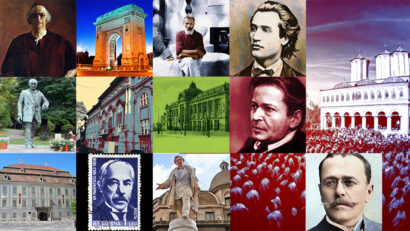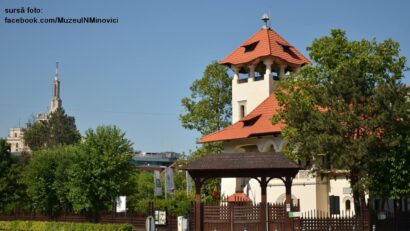Armenian Bucharest
One of the biggest entrepreneurs in Romanias history was the Armenian Amanuel Marzaian, known as Manuc-bei, who lived in the second half of the 18th century.

Steliu Lambru, 15.06.2019, 14:00
Bucharest’s ethnic diversity was mentioned by most of the people who visited Wallachia’s capital throughout time. Alongside Romanians, Bucharest was home to a number of Balkan, Central European and Oriental ethnicities. The Armenians were an important part of the latter. In spite of being a small community, their presence was important at the level of the elites, who set the trends and priorities of that time. Armenian Bucharest was a reality that left its mark in the collective memory and also in architecture. The Armenian Church is located one kilometre East of Bucharest’s centre, right next to the Armenian Street, where the neighbourhood of one of the most traumatised people in history, started. The Armenian cemetery, once located on Bucharest’s eastern outskirts, is now part of the Pantelimon neighbourhood, built in the 1970s. We couldn’t have found a better guide for the Armenian Bucharest than an Armenian ethnic, in the person of historian and journalist Eduard Antonian, one of the most active members of the Armenian community in Bucharest. He told us more bout the first Armenians in Bucharest:
Eduard Antonian: “The first evidence of the Armenian presence in this area dates back to the Middle Ages, when Armenians came to this place as traders. However, we can speak of a well established community since the time of merchant Manuc. He is the one that built the first Armenian church in Bucharest, made of wood, erected on the ruins of the present Armenian church in the 18th century, in 1760. Of course, no church could have made sense in the absence of believers, of an Armenian neighbourhood and of a school. The Armenian neighbourhood stretches between the Armenian church and Obor neighbourhood, and includes the whole Calea Mosilor Boulevard. There was never a census or any statistics that coult tell us the number of Armenians in Bucharest, but we can estimate that there were several thousands. Starting 1925, after the Armenian genocide in the Ottoman Empire, that forced them flee to these parts as refugees, the number of community members increased.”
The Armenian community in Bucharest was a dynamic one, as Eduard Antonian tells us: “Most Armenians were craftsmen, dealing in handicraft and money exchange. They were blacksmiths, shoemakers, butchers. They used to sell meat to the armies, especially to the Turks. They also took the skin of the animals and manufacture military equipment, such as boots, backpacks or bags, mostly from the Armenians in Gherla, who were the biggest animal breeders in the area. The Armenians in Gherla, in their turn, were supplying the Austrian army. They also used to give their merchandise on credit and to sell more than others and also cheaper, so the Jewish and Greek competition resented them. They were very successful in business. This tradition was preserved until the communists came to power.”
Armenian Bucharest meant especially the Armenian neighbourhood. Their daily life is recounted in their memoirs and also in the documents of that time: “The Armenian neighbourhood was very well structured, and had those specific wagon-type houses. I grew up in one of them on Calea Mosilor Boulevard. My whole family gathered there. The place where I grew up was also the place where the three Antonian brothers lived with their wives and children. There were also cousins and other relatives living there. They all got together in the yard and had big family meals in an unforgettable atmosphere. Neighbours used to know each other well, have strong relationships, have they morning coffee together and on Sundays they used to go to church together and then to the Armenian cemetery. The community was united and its members helped each other a lot.
One of the biggest entrepreneurs in Romania’s history was the Armenian Amanuel Marzaian, known as Manuc-bei, who lived in the second half of the 18th century. A businessman and a diplomat, he made it to the highest spheres of power in the Ottoman Empire and Russia. His role in the setting up of a business centre in Bucharest was essential: “When Manuc inn was erected, in 1809, he had a little market there and offered venues for small shops. The Armenians were exempted from paying taxes or rent. Bucharest’s business life gravitated around this inn. The relations with the Romanian majority had never been tense, as the Armenians were seen as fully integrated and not causing any problem. Bucharesters were very grateful to Manuc for systematizing the entire Old Centre area by building the inn. Let us not forget the Turkish invasion in the beginning of the 19th century when Manuc brought together the families of the merchandisers around him and hosted them inside his inn. He closed the gates and the Turks could not go in. Manuc brought an element of civilisation to the Bucharest of that time. It was something very trendy to be seen walking around Manuc Inn. The land on which the inn was built was sold to him by ruler Ghica at a small price, because Manuc had promised him he would rebuild the entire area.”
The traces of Armenian Bucharest are less obvious than before but some of them are still visible. Cities transform and times change, and Romanias capital is no exception to this rule.
(Translated by Elena Enache)





























